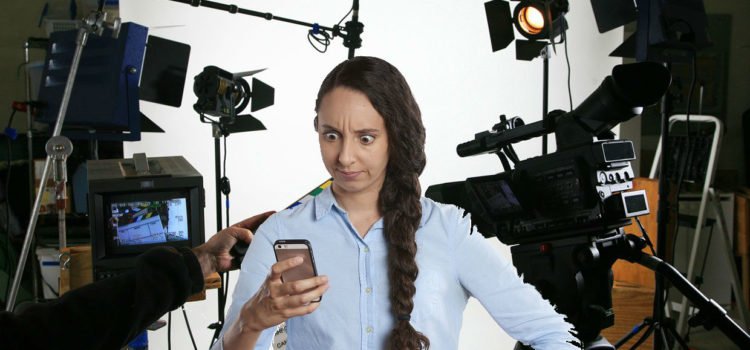We never say “don't be a runner” - a good runner on a film location is gold dust and they are a very important and valued member of any production team.
That being said, we meet so many bright young people who tell us they want to be a ‘runner' and with the benefit of our 45 years of experience in the industry, our response to them is why?
If their answer is: “I relish being the lowest paid person on a location”, “I enjoy doing everything and anything that anybody wants me to do” or “I've studied film and television for four years to be good at getting tea and coffee for other people” then we say “great” and wish them good luck with their chosen career.
But if their answer is, and it's the one we mostly hear - “everybody tells me I have to start at the bottom of the ladder and work my way up” that's when we like to take some time with them to challenge the ladder theory. We explain what's involved in being a runner and offer them an alternative mindset to go forward with.
Imagine how you would feel if after four years of hard study your peers tell you: “you have to start all over again” or “start at the bottom of a career ladder and work your way up”. Not very inspirational is it?
However here is a great link to check out if you want to explore the job in real depth: Runner. What we offer you is a quick snapshot of things from an alternative perspective.
Being a runner
This is a really, really hard and challenging job even for the smartest of people and yet it’s rewarded with the smallest amount of pay.
Being a runner means - you need to be a mind reader capable of anticipating everybody's needs and a source of all information answering a million random questions every day. You are often the first up in the morning and usually the last to bed. You have to do everything and anything that others may need you to do from gathering rubbish to delivering messages and you're expected to do it smiling and at the double. Your list of jobs will have no limits and the number of things you will be expected to juggle at the one time is often ridiculous.
You may have been told that by being a runner you will learn by watching others but as you're going to be busy all day, when will you get the time for this learning curve to happen?
There is no ladder to climb
The ‘career ladder' is the greatest myth in the industry because in film and television getting a job is mostly based on contacts and opportunity. Being in the right place at the right time is half the battle to getting work - the other half is who you know.
When these two elements come together work opportunities will frequently drop at your doorstep...also a quiet ‘word of mouth’ from a connected person into the right ear will generally go a lot further than any experience you may have.
This sounds very cynical but it's true...even within broadcast institutions such as the BBC/ITV/CH4.
Finally, it is worth noting that most jobs will only last for the duration of filming and then you're out looking for another job. So where is the workplace continuity that's required to implement a career ladder path?
Our alternative mindset
Take charge of your own career, make your own jobs, train yourself and do the things you want to do...by simply doing them.
The tech is already there for you. Mobile phones for filming, free editing packages on the internet, YouTube for training, mates for teamwork and social media channels for broadcasting your films to an audience. What more do you need other than an idea for your film.
Make your money to live by stacking shelves in a supermarket if you have to but at the same time be constantly asking yourself what you should be doing in your own time to take charge of your career.
If you start with the mindset of you are already in film and television because you want to be, then you must accept that it’s only you wasting your time and only you are to blame if you're not doing anything.
Don't wait for an opportunity to arrive - GET OUT THERE AND DO IT!
Keep an eye open for more blogs to come. Meanwhile, give us a call on 0131 622 0220 to see if we can offer you support in your career.
Check out more of our website and if you have any questions email us at [email protected] and we will get back to you.
So, how do you get started on a career in television? Once upon a time, you would have been told "fingers crossed, it's a lucky dip, keep applying and good luck because television work is exclusive and at the very minimum you need to know someone on the inside just to get you an introductory meeting."
The good news is things have changed dramatically and are a lot easier now.
Broadcasters and production companies all have websites and job opportunities are posted online. They tell you how to apply, the qualifications you need and how much you will get paid. All you have to do is fill in the form and wait for response alongside thousands of others.

Almost every day LA Media meets bright young people who want a career in television and based on our 45 years of experience in television production we tell them what we think. It's not ‘typical advice’ but it has worked for many. So if you want to find out what we tell them, then this is for you.
Don't put your future in the hands of others
You could always join the ‘work lottery’ by simply applying for jobs and waiting for replies. However, this can be very demoralizing, especially when your excitement is met with silence.
You need to understand that you are in charge of your future and no one else is to blame if you allow your time to slip away.

Never catch yourself doing nothing
1. Use your time pro-actively by checking out what the production companies like the BBC and independents are making.
2. Consider what you watch on television in an analytical way. Work out what you like and don't like and then understand why - this will help you gain a clearer picture of the creative path you should be following.
3. Visit production websites and get to know what they make, what they have made in the past, discover the names of the people that lead these companies, and reach out to them through the website. Ask them for a quick meeting or a short chat. Before you do, make sure you know what you want to talk about. It really helps!

4. Cameras, lenses, audio gear, lighting and editing are all areas you should study up on while you are waiting for meetings to happen. YouTube has info on anything you can think of and you should use it to increase your technical knowledge. Most importantly don't just watch one - watch hundreds and very soon you will learn to ‘talk the talk’.
5. Help yourself by building up a bigger and more informed picture of the industry you want to work in. This knowledge will let others know that you are serious about a career in television and that always goes over well when you are in conversation with people who could give you work.
What are you working on?
1. Time to spare - you shouldn't have any! If you do then use it to make your own films. Most mobile phones have a video option and there is also free editing software available online. All you need is an idea to start making your own films.

Filming your own ideas is also a great way to simply get better. You will prove to yourself what you already know and at the same time highlight areas you need to find out more about. It also provides a talking point for when you meet others in the industry as most conversations with them will start with the question - so what are you working on?
2. What's your idea? This is the fun part and yet for a lot of people, it's also the most challenging. Whether it’s a good idea or a bad idea is irrelevant, it just has to be an idea that will get you motivated to get up and get out filming.
3. Collaborate with others - it can be very lonely out there, so we would always encourage you to get some friends involved with any project you are doing. Discuss your ideas with them and even use them as your presenters, crew, or actors when required. Get onto your social media outlets and ask other passionate filmmakers to join you on your project. You’ll meet new people and get new perspectives.
4. Publish - let people see what you are making and what you can do. Don’t judge your films to the point where you do nothing with them because in your eyes they are not perfect. Be brave, put them out there on social media channels, and take the feedback. You can decide what comments you listen to and ignore the inevitable trolls that will surface.

As ever, if you have any more questions about starting a career in television or would like to learn a bit more about what we do here at LA Media, just get in touch via email at [email protected] or through the contact page on the website.
Zoom has become part of our daily lives. It’s time-efficient, easier to schedule, eliminates travel, and is a great platform for keeping in touch while social distancing.
However, it comes with one major challenge - how to look your best when on screen.
Have you ever gazed at the small screen during a chat and thought “yikes”. Well before your self-esteem is left in tatters please check out my 5 top tips on how to look better on Zoom.
It really is possible to avoid looking like a ‘ghoul lurking in the shadows without needing a whole production crew, makeup artist, and CGI expert.
Prepare for the Meeting
Before your meeting it's important that you take some time to consider my five key points:
1. What are you going to wear?
2. Think about your background?
3. What is your light source?
4. Where’s your microphone located?
5. Do you know where to look?
Consider these 5 points in advance of any meeting and you will feel assured about how you look and have more self-confidence about how you appear to others when on ZOOM.
1. What are you going to wear?
It’s not a vanity thing - it's a sensible thing. We are often judged by the clothes we wear so it’s important you get this right.
Your clothes should be something you feel comfortable with and confident wearing. An outfit should reflect your personality, but keep in mind it should also be appropriate. So maybe don’t wear your bathrobe to the Monday meeting….unless you’re that type of office.
Choose colours that will contrast against your background. This ensures you don’t blend into it. Avoid extremes of colour such as ‘all white’ as this will affect your camera's settings, resulting in poor picture quality...and finally a golden rule...hold back on the stripes.
2. Think about your background
Backgrounds are a major part of the picture you present to others. To look your best, your background needs to look its best as well.
Keep things simple by avoiding fascinating clutter. Lights, lamps, and windows in the background are the most common problems because when picked up by your camera's sensors the result is often a great-looking background - but a face hidden in the shadows.
Easy solutions... simply turn things off or move them out of the way. Think about shutting the blinds on windows. What you have to say is important and attention should always focus on you. A poor background can be a real distraction for anyone watching you...but just a few minutes of thought and a quick tidy-up will pay off big time and keep you looking great.
3. What is your light source?
All cameras need light for them to work effectively. So you will need to have some kind of light on your face in order to be seen at your best.
You can make use of light from a window, a desk top lamp or a ceiling light in your room...lots of options. However... if the light on your face is too bright your face will disappear through overexposure... if it’s too low then it will be assigned to the shadows and your face should always have more light than your background.
The answer...try out as many variables as you can.
Switch things on and off, close or open curtains, point lamps at walls for a reflective light, and just keep going until you find the lighting combination that works best for you.
Finally, be aware that significant lighting changes may occur if you decide to alter your position during a ZOOM.
4. Where is your microphone located?
Sound and Vision go together so having made the effort to look good - it's now time to consider how you are going to be heard.
The first step is to know where your microphone is and then talk in its direction. Most audio devices are described as being omnidirectional which really helps things, especially if you are someone who likes to turn their head a lot during a Zoom session.
It’s important to note that the closer you are to your microphone the louder you will sound...the further away, the quieter. You can avoid sudden changes in volume levels by trying to keep your mouth a constant distance from your microphone.
5. Do you know where to look?
You must learn to look at the camera when you’re talking or listening to others, and you must learn to listen without looking at the person speaking. This is probably the most difficult point to master on your road to looking better on ZOOM and while all five points matter this is the most significant.
As with any video conferencing software, in Zoom, your camera is the eye of your audience. One of our most intuitive responses when talking to others is to look them in the eye. In Zoom you look into your camera.
This will feel unnatural in the beginning. Through practice, you will master this skill and make your ZOOM communication better and stronger. Participants will feel that you are looking directly at them and as a result, this will enhance their experience of you because in their mind...you’re making that critical eye contact.
So there you have it...my 5 key points. It took me several ZOOM meetings before I felt comfortable with all 5 of these points. So please remember - if you get them right on your first attempt, you will be doing much better than I did.
Good Luck!
If you'd like to get any more advice or simply want to check out what we do here at LA Media, why not get in touch via our website at lamedia.co.uk or give us a call on +44 (0)131 622 0220.
So why video? Well, you know that old saying a picture is worth a thousand words? Well, now the picture has officially been replaced by the video. Facebook users alone watch 8 billion videos per day, that’s one reason that why video is considered one of the best marketing tools a company can have.
Video by LA Media 'Why Video is so Important'
Guess video did kill the radio star after all… however, the facts and figures don’t lie and the bottom line is that video is king. Cisco projects that global Internet traffic from videos will make up 80% of all internet traffic by 2019.
Whether it’s buying a product or trusting a company to deliver a service - people don’t like pushy pitches. They want information so they can make what feels like an informed decision.
Considering that YouTube reaches more 18+-year-olds during prime-time viewing hours than any cable TV network it is hard to ignore the value of video.
An engaging video is a versatile visual asset that can be used in so many ways to improve your brand. That is why in this blog we look at the five reasons why video is going to be a worthwhile asset to add to your company’s marketing strategy.
What video can do for you
1. Use video to improve your sales
Did you know that enjoyment of video ads increase purchase intent by 97 percent and brand association by 139 percent? Another study showed that marketers who used video grew their revenue 49% faster than non-video users.
A video is a great medium to deliver a clear concise message. Instead of asking your customers or stakeholders to read about you, you can show them why you are the top dog. Nowadays, your customers will probably wonder why you don’t have a video!
It has been estimated that at least 55% of people watch videos online every day. So if you don’t have a video online you are missing out on a sizable segment of the market.
According to a report published by Forrester, including video in an email leads to a whopping 200-300 percent increase in click-through rate.
2. Use video to improve your SEO
If you want to improve your website’s ranking then quality original content is key. A good regular blog, a frequently updated website, and a fresh snappy copy will all help to achieve this.
But ever since Google bought YouTube, a high-quality video has become critical for SEO rankings and converting prospects into customers. Websites with video tend to keep users engaged for longer. According to Unbounce by including a video on your homepage you can increase conversion rates by 20 percent or more.
In fact, video boosts organic traffic by about 157% from search engines, prompts a 105% increase in time spent on a site, and leads to about 2X the number of conversions compared to a site with no video.
This benefit isn’t limited to your website. As we’ve mentioned this video is an asset! You can also share it via your various social media platforms. It will increase the impact and reach of your video and user engagement, all of which ultimately boost your SEO!
By creating your own YouTube channel and posting your video to your Google+ page you can increase your search engine bump by adding targeted keywords in your video title, tags, and descriptions. An added bonus is you won’t run the risk of being penalised by Google for duplicated content.
3. Extend your reach with a video!
Advertisers on prime-time broadcast TV could have reached 56% more 18-49-year olds by also advertising on YouTube.
Sharing is caring and you are more likely to get a user to share your content if it is a good video! Having a well-shared video or even a viral video is good for your brand.
Research has shown that brand recall and brand association rose 7% among viewers who had been recommended a video versus viewers who found it by browsing.
A video is more likely to get you shares on social media! Social video generates more than 1,200% more shares than text and images alone.
4. Stand out in the crowd
Cisco project that by 2020 every second, nearly a million minutes of video content will cross the network. Not only is it a powerful medium but you can use it as a tool to differentiate yourself from your competition. Your visual assets are important, they are your chance to showcase your unique company personality, culture, and brand ethos in a relatable way.
Your visual assets are important, they are your chance to showcase your unique company personality, culture, and brand ethos in a relatable way.
A memorable well-crafted video will give you stronger brand recognition than any text can.
According to NIELSEN Wire, 36 percent of online consumers trust video ads. But on the flip side, 61% of users say they have been put off buying a product after watching a bad explainer video.
This is why you need to get a great production team that understands your needs and delivers a final product that meets your brief.
Did you know that 85% of Facebook video is watched without sound? Your video will need to have excellent visuals and not depend too strongly on a soundtrack.
You should consider the use of some engaging subtitles so your content will be understood without sound too!
Videos need to be punchy and engaging from the moment they start.
5. Improve Communication
According to Animoto, 4 times as many consumers would rather watch a video about a product than reading about it.
Videos keep your audience interested, even during boring subject matter! This is why video is such a great tool. It makes complex content more relatable.
And while well-written content is effective for many audiences, visual marketing is an even more powerful tool to increase interactions and actions.
After all, it takes less effort to watch a video than to read a text. In summation "We're entering this new golden age of video" - Mark Zuckerberg on social media sharing and video.
We hope that this blog has been enlightening and will help inspire your next project. If you enjoyed this blog don’t forget to follow us on: Twitter, Facebook, and Instagram for your daily dose of media & drone chat!
Visit our website lamedia.co.uk and if you have any questions, e-mail us at [email protected] or give us a call on 0131 622 0220















